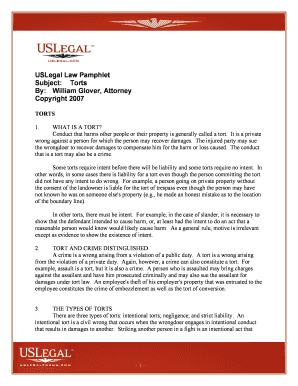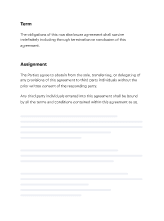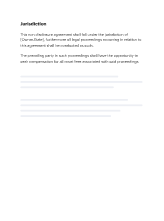- 1 - USLegal Law PamphletSubject: TortsBy:William Glover, Attorney Copyright 2007TORTS1.WHAT IS A TORT? Conduct that harms other people or their property is generally called a tort. It is a private
wrong against a person for which the person may recover damages. The injured party may sue
the wrongdoer to recover damages to compensate him for the harm or loss caused. The conduct
that is a tort may also be a crime.Some torts require intent before there will be liability and some torts require no intent. In
other words, in some cases there is liability for a tort even though the person committing the tort
did not have any intent to do wrong. For example, a person going on private property without
the consent of the landowner is liable for the tort of trespass even though the person may have
not known he was on someone else's property (e.g., he made an honest mistake as to the location
of the boundary line).In other torts, there must be intent. For example, in the case of slander, it is necessary to
show that the defendant intended to cause harm, or, at least had the intent to do an act that a
reasonable person would know would likely cause harm. As a general rule, motive is irrelevant
except as evidence to show the existence of intent. 2.TORT AND CRIME DISTINGUISHED A crime is a wrong arising from a violation of a public duty. A tort is a wrong arising
from the violation of a private duty. Again, however, a crime can also constitute a tort. For
example, assault is a tort, but it is also a crime. A person who is assaulted may bring charges
against the assailant and have him prosecuted criminally and may also sue the assailant for
damages under tort law. An employee's theft of his employer's property that was entrusted to the
employee constitutes the crime of embezzlement as well as the tort of conversion. 3.THE TYPES OF TORTS There are three types of torts: intentional torts; negligence; and strict liability. An
intentional tort is a civil wrong that occurs when the wrongdoer engages in intentional conduct
that results in damages to another. Striking another person in a fight is an intentional act that
- 2 - would be the tort of battery. Striking a person accidentally would not be an intentional tort since
there was not intent to strike the person. This may, however, be a negligent act. Careless
conduct that results in damage to another is negligence. Generally, liability because of a tort only arises where the defendant either intended to
cause harm to the plaintiff or in situations where the defendant is negligent. However, in some
areas, liability can arise even when there is no intention to cause harm or negligence. For
example, in most states, when a contractor uses dynamite which causes debris to be thrown onto
the land of another, the landowner may recover damages from the contractor even though the
contractor was not negligent and did not intend to cause any harm. This is called strict liability
or absolute liability. Basically, society is saying that the activity is so dangerous to the public
that there must be liability. However, society is not going so far as to outlaw the activity.The Coleman Construction Company was constructing a highway. It was necessary to
blast rock with dynamite. The corporation's employees did this with the greatest of care. In spite
of their precautions, some flying fragments of rock damaged a neighboring house. The owner of
the house sued the corporation for the damages. The corporation raised the defense that the
owner was suing for tort damages and that such damages could not be imposed because the
corporation had been free from fault. Was this defense valid? No. While ordinarily fault is the
basis of tort liability, there are cases in which absolute liability is imposed on the actor. This
means that when harm is caused, it is no defense that none was intended or that due care had
been exercised to prevent the harm.Examples of absolute liability situations would be harm caused by storage of flammable
gas and explosives, crop dusting when the chemical that is used is dangerous, factories which
produce dangerous fumes, smoke or soot in populated areas, and the production of nuclear
material.No-fault liability is another name for absolute liability. No-fault liability is based on
statutes. Many states have no-fault statutes with regard to automobile accidents. In other words,
payment is made for injury regardless of who is at fault. The persons and property who are
damaged are allowed to recover regardless of who is at fault. Of course, insurance is a vital key
in this type of no-fault situation.Another example of no-fault liability is workmen's compensa tion. In workmen's
compensation, the employer is responsible to compensate an employee is injured on the job
while engaging in his employment. Most employers have insurance that covers such situations.
However, if the employer does not have insurance, he can still be liable for damages regardless
of whether or not the employer was negligent. Also, generally, negligence on the part of the
employee is irrelevant.
- 3 - INTENTIONAL TORTS4.FALSE IMPRISONMENT False imprisonment involves detaining a person without that person's consent. It can take
the extreme form of kidnapping or the less extreme for of detaining a shopper for suspected
shoplifting without reasonable grounds.A defense to false imprisonment would be consent of the detainee, or if a store owner had
reasonable grounds to believe that the detainee was guilty of shoplifting (shopkeeper’s
privilege). This privilege allows a store owner (or his employee) to detain a suspected shoplifter
based on reasonable suspicion for a reasonable time. This privilege applies even if the store
owner was wrong about the customer so long as the owner actions were based on reasonable
suspicions and treated the customer in a reasonable manner. This privilege does not protect the
owner from unnecessary force in detaining the customer.A customer was shopping at the handbag counter of the defendant's store. She did not
make any purchase and left the store. When she was a few feet away from the store, an
employee of the store tapped her lightly on the shoulder to attract her attention and asked her if
she had made any purchase. When she inquired why, he asked, "What about that bag in your
hand?" The customer said that it belonged to her and she opened it to show by its contents that it
was not a new bag. The employee gave the customer a "real dirty look" and went back into the
store without saying a word. The customer then sued the store for false imprisonment. Was the
store liable? No. Judgment would be for the store. There was no false imprisonment because
there was no actual detaining of the customer. The circumstances did not show the use of force
or threat of force that stopped the customer from proceeding. Her action of stopping and
showing the contents of her handbag was voluntary. 5.INTENTIONAL INFLICTION OF EMOTIONAL DISTRESS At one time, a person could not recover mental distress unless there was a tort associated
with the mental distress. However, there is now a separate tort for intentionally causing mental
distress. This tort arises when a defendant purposely subjects a plaintiff to unnecessary
emotional distress. Outrageous conduct must generally be present. For example, if a person
bawls someone out in public with the intent to humiliate the person, this could possibly be the
tort of intentional infliction of mental distress. Damages must be proven, however. A collection
agency who uses harassing techniques to collect a debt could possibly be held liable for
intentional infliction of mental distress. 6. INVASION OF PRIVACY Invasion of privacy is a relatively new tort. This right is violated in one of the following
ways: invasion of physical privacy such as planting a microphone in a person's home or peering
through a person's window; giving unnecessary publicity to personal matters of the plaintiff's
life; or exploiting a person's name or picture without permission such as using them in
advertising without permission. In some states, a person is guilty of invasion of privacy if he
interferes with the person's right to be let alone or be free of unwarranted publicity. A defense to
a charge of invasion of privacy is that the person making the disclosure had a legitimate reason
- 4 - for doing so. For example, investigation of a person's credit when the person has applied for a
loan is a legitimate reason. Investigation of insurance claims are privileged.7.DEFAMATION A form of publication which tends to cause one to lose the esteem of the community is
defamation. This is injury to reputation. A person is liable for the defamation of another. In
order to prove defamation, the plaintiff must prove: �that a statement was made about the plaintiff’s reputation, honesty or integrity that is not
true;�publication to a third party (i.e., another person hears or reads the statement; and�the plaintiff suffers damages as a result of the statement. Slander is a form of defamation that consists of making false oral statements about a
person which would damage that person's reputation. If I spread a rumor that my neighbor has
been in jail and this is not true, I could be held liable for slander. Defamation which occurs by
written statements is known as libel. Libel also may result from a picture or visual representa-
tion. Truth is an absolute defense to slander or libel. Some statements, while libelous or slanderous, are absolutely privileged in the sense that
the statements can be made without fear of a lawsuit for slander. The best example is statements
made in a court of law. An untrue statement made about a person in court which damages that
person's reputation will generally not cause liability to the speaker as far as slander is concerned. However, if the statement is untrue, the person making it may be liable for criminal perjury. If a communication is made in good faith on a subject in which the party communicating
it has a legitimate right or interest in communicating it, this communication may be exempt from
slander liability due to a qualified privileged. Carrigan, a district manager of Simples Time Recorder Company, was investigating
complaints of mismanagement of the Jackson office of the company. He called at the home of
Hooks, the secretary of that office. She expressed the opinion that part of the trouble was caused
by stealing of parts and equipment by McCall, another employee. McCall was later discharged
and sued Hooks for slander. Was she liable? No. The circumstances of the investigation, the
relevance of the matter to the employer's business, and the fact that the statement was privately
told to a superior led to the conclusion that Hooks did not make the statement with malice.
Because the statements were nonmalicious and were made to the employer regarding a matter
within the range of corporate business, Hooks was protected by a qualified privilege from
liability for slander.The media also enjoy a qualified privilege for stories that turn out to be false as long as
the information was released without malice (i.e., intent to harm) and a retraction or correction is
made when the matter is brought to the attention of the publishing party.
- 5 - 8.PRODUCT DISPARAGEMENT Damages may also result from the tort of disparagement of goods or slander of title. This
would occur when a person makes a false statement about one businessman's title to goods or the
quality of goods, and the result of the statement causes another person to refrain from dealing
with the plaintiff. 9. WRONGFUL INTERFERENCE WITH CONTRACTS Wrongful interference with a person's contract or with his right to earn a living can be a
tort. This tort has been called contract interference or tortuous interference with contracts or
tortuous interference. The interference must generally be intentional and without legal
justification. Of course, the right to make a living or to conduct one's business is subject to the
rights of others, and legitimate competition between businesses in seeking to gain customers
would not give rise to this tort. This tort can be difficult to prove because of the right of
competition. Generally, it is necessary to prove that the defendant intentionally persuaded
another to breach a contract with the plaintiff. In a 1988 Texas case, a city hired a consulting engineer who recommended that the city
terminate the contract of a person because of the person's defective work. The consulting
engineer was held not liable for intentional interference with the terminated employee's contract
because the consulting engineer was under a duty to keep the city properly informed of the
quality of the employee's work which was defective. However, if the consulting engineer
advised the city to fire a clerical worker just because the consulting engineer did not like the
clerical worker, this could possibly give rise to the tort of intentional interference with the
contract of another. 10.TRESPASS A trespass is an unauthorized action with respect to a person or property. A trespass to
the person consists of any contact with someone's person for which consent was not given. This
is technically described as a battery. An assault would be a situation where a plaintiff reasonably
believed a battery upon his person was about to be committed, but he was not in fact touched.
An example of an assault would be where one person swings his fist at another person but
misses. If the person made contact, this would be an assault and a battery. A defense to assault
and battery would be in cases of self defense.A trespass of land involves going on or above the property of another without permission.
A trespass can involve the unpermitted use of the airspace of another's property as well as
actually going on the property. However, this rule has been modified to allow the flight of
aircraft above the land as long as it does not interfere with the proper use of the land.A trespass to personal property is the use of someone’s property without person. A
conversion occurs when personal property is taken by a defendant and kept from its true owner
without permission of the owner. Conversion is the civil side of the crime of theft.
- 6 - 11.COMPUTER TORTS Damage to the hardware of a computer will impose tort liability under the same
principles of law as would apply if it were a typewriter or a car or any other tangible property.
Intentionally damaging software can also give rise to civil liability. Theft of computer hardware
or software constitutes the tort of conversion.Negligent use of a computer is a tort. If someone knows that a computer is not operating
properly, but continues to use it and causes damages to a third person due to computer error, the
computer user can be liable for negligence. A company may be liable to persons who are
harmed because the company's management: GNegligently failed to maintain its computers, resulting in computer error; orGNegligently hiring, or failing to supervise, its computer operators. When an insurance policy does not expressly state that it covers computer property, a
question may arise as to whether hardware, software, and a database are protected by such a
policy. It has been held that a computer tape and the data stored on the tape are protected by an
insurance policy covering damage to tangible property.The law regarding protection of privacy applies whether a computer is involved or not.
However, computers have resulted in a greater awareness of possible invasions of privacy. This
is because so much information can be stored in computers very quickly and easily. Therefore,
computers can share information about you and can compile a great deal of data about you in one
place. A person who wrongfully discloses personal, computerized, information regarding others can be liable for damages. A company may be liable if it negligently hires, or fails to supervise,
an employee who releases private information regarding others. In some States, a firm may be
liable if it maintains inadequate computer security, thus enabling an outsider to obtain private
information.A person's credit standing or reputation can be damaged if a computer contains false
information, and this false information is supplied to a third person. In order to avoid liability,
the person in control of the data must exercise reasonable care to prevent errors and to correct
errors. Liability under this theory would be called defamation by computer.Employers in East Berwick formed an association to exchange information on job
applicants. In a computer, the association stored information received from members about the
grounds for discharging employees. Maria had been employed as a bank teller. She was later
fired because she was arrested for embezzlement of bank funds. Maria was never able to obtain
other work in the community because of the computer printout of the association showing her
arrest. She sued the association for defamation. It raised the defense that the computer did not
lie--she had been arrested for embezzlement. She replied that it was publicly known that shortly after she was arrested, she was released because it was established that the embezzlement had
been committed by a cashier in the bank and that the cashier was arrested and convicted for the
crime. Is the association protected by the fact that the computer was correct in what it stated? No.
The association was clearly negligent in failing to update its records. It was obvious that Maria’s
- 7 - arrest would have a significant effect on her reputation. The association was therefore under the
duty to take notice of the conviction of the cashier and to clear the record as to Maria. Having
failed to do so, the association is not protected from defamation liability on the ground that it was
a computer made statement.12.NEGLIGENCE The widest range of tort liability today is in the field of negligence. Negligence is the
failure to follow the degree of care that would be followed by a reasonably prudent person in
order to avoid foreseeable harm. A person can be negligent if he or she acts with less care than a
reasonable person would use under similar circumstances.Burnstein drove a car on a country road at 35 miles an hour. The maximum speed limit
was 45 miles an hour. He struck and killed a cow that was crossing the road. The owner of the
cow sued Burnstein for the value of the cow. Burnstein raised the defense that since he was not
driving above the speed limit, there could be no liability for negligence. Was this defense valid?
No. A person must at all times act in the manner in which a reasonable person would act under
the circumstances. The fact that Burnstein was driving within the speed limit was only one of
the circumstances to consider. The weather or the condition of the road may have made it
unreasonable to drive at 35 miles an hour. Driving slower than the speed limit does not in and of
itself prove that the driver was acting reasonably.The reasonable person standard varies in accordance with the situation. Generally, when
a jury is involved, what is reasonable is what the jury thinks is reasonable. If the judge is the
fact finder, the standard is what the judge believes is reasonable.The degree of care required of a person is that which an ordinarily prudent person would
exercise under similar circumstances. This does not necessarily mean a degree of care that
would have prevented the harm from occurring. This degree of care varies. For example, if one
is engaged in a service involving skill (such as a medical doctor) the care must be measured in
light of what an ordinarily prudent skilled person (e.g., doctor) would be. The question the jury
seeks to determine is what care and skill would reasonably be expected under the circumstances
involved in the case.Malpractice is a failure by an physician or other professional to use the care and skill that
other members of their profession would use under similar circumstances. When an accountant,
doctor, attorney, or some other professional contracts to perform services, there is a duty to
exercise skill and care as is common within the community for persons performing similar
services. Failure to fulfill that duty is malpractice.The elements required to establish negligence are: Gduty; G voluntary act or failure to act that breaches the duty; Gcausation; andG damages (i.e., the breach of duty causes harm to the plaintiff).
- 8 - Torts involve duties created by law. Just because someone is hurt does not mean that
someone else must pay for the harm. There must have been a duty which has been broken. A
plaintiff will not be allowed to recover from a defendant if the defendant did not break a duty
that was owed to the plaintiff. For example, if a burglar breaks into my house and trips over an
item of furniture, I am not liable to the burglar because I had no duty to him. However, if a guest
in my house trips over a piece of furniture, I may have a duty to that guest. The breach of duty must result from a voluntary act or failure to act. Blaylock was a voluntary psychiatric outpatient treated by Dr. Burglass. Dr. Burglass
became aware that Blaylock was violence-prone. Blaylock told Burglass that he intended to do
serious harm to Wayne Boynton, Jr. Shortly thereafter he killed Wayne. The parents of Wayne
then sued Dr. Burglass on the theory that he was liable for the death of their son because he
failed to give warning or to notify the police of Blaylock's threat and nature. Decide. The court
held that there was no liability because there was no duty to communicate any warning. The
court reached this result on the ground that psychiatry is not such a precise science that the
doctor would know that a real danger existed, and it would tend to undermine the confidentiality
of the psychiatrist-patient relationship if the psychiatrist were required to give warnings.In order for someone to be legally responsible for damages, it is necessary to show that
the wrongful act was the cause of the harm. The legal term is that the act must be the proximate
cause of the harm. Henry Neiderman was walking with his small son. An automobile driven by Brodsky
went out of control, ran up on the sidewalk, and struck a fire hydrant, a litter pole and basket, a
newsstand, and Niederman's son. The car did not touch Niederman, but the shock and fright
caused damage to his heart. He sued Brodsky for the harm that he sustained as the result of
Brodsky's negligence. Brodsky defended on the ground that he was not liable because he had not
touched Neiderman. Was this a valid defense? No. If the plaintiff can establish that Brodsky’s
negligence was the proximate cause of Niederman’s physical injury, it is immaterial that no
impact occurred.Defendant no. 1 parked his truck in the street near the bottom of a ditch on a dark, foggy
night. Iron pipes carried in the truck projected beyond the truck nine feet in back. Neither the
truck nor the pipes carried any warning light or flag, thus violating both city ordinance and state
statute. Defendant no. 2 was a taxicab owner whose taxicab was negligently driven at an
excessive speed. Defendant no. 2 ran into the pipes, thereby killing the passenger in the taxicab.
The plaintiff brought an action for the passenger's death against both defendants. Defendant no.
1 claimed he was not liable because it was the negligent act of defendant no. 2 that had caused
the harm. Was this defense valid? No. The court applied the substantial cause test. Each
defendant had been a substantial cause of the plaintiff's harm. Accordingly, neither defendant
could defend on the ground that another person, the other defendant, had also been a cause of the
harm.
- 9 - The final element of negligence is damages. A plaintiff may recover monetary damages
to compensate the plaintiff for economic losses such as lost wages and medical expenses. A
plaintiff may also recover noneconomic losses such as for pain and suffering. Punitive damages
may also be appropriate. Punitive damages are designed to punish the defendant for his
wrongdoing and are generally only appropriate if the plaintiff can prove gross negligence or
willful misconduct. 13.DEFENSES TO NEGLIGENCE If the negligence of the plaintiff is partially responsible for his harm, his recovery from
the defendant may be reduced or barred. This is called contributory or comparative negligence.
In a small minority of states, the common law contributory negligence rule is followed which
states that if the plaintiff contributes to his harm, he cannot recover from the defendant. In most
states, this rule has been rejected because it has been regarded as unjust in situations where the
plaintiff's negligence was slight in comparison to the defendant's negligence. Comparative negligence provides that there should be a comparing of the negligence of
the plaintiff and the defendant. This is the rule followed in most states. The negligence of the
plaintiff would not bar recovery in the states, but would only reduce the plaintiff's recovery to the
extent that the harm was caused by his fault. For example, if the jury decides that the plaintiff
has sustained damages of $100,000.00, but that his own negligence was one-fourth the cause of
the damage, the plaintiff would only be allowed to recover $75,000.00. Some states combine the
contributory and comparative negligence rules and refuse to allow the plaintiff to recover
anything if his negligence is more than 50% of the cause of the harm.Assumption of risk is a defense which a defendant can raise which basically states that
the plaintiff has knowingly assumed the risk of the harm that was caused. A person hit by a
baseball at a baseball game has assumed the risk of getting hit because it is a known danger that
baseballs are hit into the stands during a baseball game. However, the doctrine of assumption of
risk has been watered down by the doctrine of comparative negligence. For example, if a
plaintiff drives an automobile knowing his brakes are defective and he fails to stop at a railroad
crossing and is therefore hit by a train, comparative or contributory negligence would be more
appropriate than assumption of risk, although the plaintiff could arguably be deemed to have
assumed the risk of an accident by driving with defective brakes that he knew to be defective.Kendra Knight took part in a friendly game of touch football. She had played before and
was familiar with football. Michael Jewett was on her team. In the course of play, Michael
bumped into Kendra and knocked her to the ground. He stepped on her hand, causing injury to a
little finger that later required its amputation. She sued Michael for damages. He defended on
the ground that she had assumed the risk. Kendra claimed that assumption of risk could not be
raised as a defense because the state legislature had adopted the standard of comparative
negligence. Decide. Kendra was not negligent in taking part in the game. There was nothing in
the fact of participation in the game that would have alerted a reasonable person to the fact that
such an injury was foreseeable. By taking part in the game, she voluntarily assumed risks of
normal harm that could reasonably be associated with the game. Her experience with the game
- 10 - showed that she knew what could be expected, and there was no proof that the defendant acted
recklessly or caused harm intentionally. That is, nothing went beyond the reasonable
expectations of a reasonable person. Thus, the comparative negligence statute did not apply, and
Kendra was barred by her assumption of risk.14.LIABILITY FOR NEGLIGENCE Certain persons and entities are not subject to tort liability. This is called immunity from
liability. Governments are generally immune from tort liability. Both states and the federal
government have abolished governmental immunity by statute in some situations. For example,
under the Federal Tort Claims Act, damages may be recovered from the United States for the
negligence of any employee of the United States under circumstances that the United States, if a
private person, would have been liable.Very young children are immune from tort liability.Some jurisdictions recognize the tort of negligent infliction of mental distress. The
element of intent is not necessary, but one must prove that the distress resulted from the
negligence of the defendant. Bystanders who witness the negligent conduct of a defendant and
who are caused mental distress may also recover under this tort in certain situations. Most courts
limit this liability to spectators who are closely related to the person who is injured by the
defendant’s negligence. 15.TORT REFORM Tort Reform is basically an effort to control the amount of damages a plaintiff can
recover. This effort is the result of the number of damage claims filed each year and the size of
jury verdicts which are sometime far in excess of actual damages like loss of wages and medical
bills. Damages for pain and suffering have sometimes been outrageous and resulted in higher
liability insurance premiums for many of us. Also, punitive damage awards can cripple a
company. Some states have imposed limits on the amount of damages that can be recovered in
certain tort lawsuits. RES IPSA LOQUITUR The plaintiff ordinarily has the burden of proving that the defendant did not exercise
reasonable care and was therefore negligent. The doctrine of res ipsa loquitur (the occurrence or
thing speaks for itself) permits an inference of negligence when: the event is of a kind which
ordinarily does not occur in the absence of someone's negligence; it is caused by something
within the exclusive control of the defendant; it is not due to any voluntary action or
contribution on the part of the plaintiff; and (4) the defendant has superior knowledge as to the
cause of the event. Examples of this doctrine would be its application in the case of objects such
as bricks or window panes falling from the defendant's premises, falling elevators, the collapse
of structures, and the escape of gas or water from the gas or water main.In a Missouri case, Collete Bass worked in a building owned by Nooney Company. As
part of her job, she was going from one floor to another when the elevator stopped moving. She
- 11 - was alone in the elevator for about an hour before she was rescued. The emergency phone in the
elevator was dead. She sued the Nooney Company for the mental distress to which she was
subjected. The Nooney Company claimed that it was not liable because there was no proof that
it had been negligent. Bass claimed Nooney had the burden of proving that it was not negligent.
Was she correct? Yes. The concept of res ipsa loquitur justified the conclusion that Nooney was
negligent, and Nooney had the burden of disproving that inference. Res ipsa loquitur has
frequently been applied in elevator cases because it applies when (a) the occurrence resulting in
injury is such as does not ordinarily happen if those in charge use due care; (b) the
instrumentalities involved are under the management and control of the defendant; and (c) the
defendant possesses superior knowledge or means of information as to the cause of the
occurrence.NEGLIGENCE PER SE If a defendant is violating a statutory law which results in harm to the plaintiff, the
defendant is deemed negligent and liable for the harm. This is negligence per se. Most courts
narrow this doctrine, making the defendant liable only if the statute which has been broken was
intended to protect against the kind of harm that was caused. For example, in a lawsuit over an
automobile accident, the fact that the defendant was driving without proper tags in violation of
an automobile registration law would be irrelevant. However, if the defendant were speeding
and this could be proven, this could be held negligence per se.A statute required that air vent shafts on hotel roofs have parapets at least 30 inches high.
Edgar Hotel had parapets only 27 inches high. Nunneley was visiting a registered guest at the
Edgar Hotel. She placed a mattress on top of a parapet. When she sat on the mattress, the
parapet collapsed and she fell into the air shaft and was injured. She sued the hotel, claiming that
its breach of the statute as to the height of the parapets constituted negligence. Decide.
Judgment was for the hotel. The statute requiring parapets was designed to protect people from
the hazard of stumbling and falling into unguarded air shafts, not to provide safe seats.
Moreover, the fact that the parapet was only 27 inches high had nothing to do with the harm, as it
would have occurred equally under the facts had the parapet been 30 inches high. DIVISION OF LIABILITY In situations where two or more defendants have caused harm to the plaintiff as a result
of the defendants' negligence, they may be held jointly and severally (i.e., collectively and
individually) liable. Except in partnership situations joint and several liability can generally only
arise when it is not possible to determine how much harm was caused by each person involved. FRAUD Fraud is a tort, and a person is entitled to recover damages for any harm caused by fraud.
Therefore, people are protected from false statements made with knowledge of the fact that the
statements were false. An example of fraud is where a company advertised that it had expertise
in tax matters, and the plaintiff allowed this company to prepare its tax return, and the tax return
was prepared by someone who was not qualified and was in fact a former construction worker
with no special training in tax return preparation. The fraud involved was the misrepresentation
- 12 - to the public that tax returns prepared by this company were prepared by experts. Midwest
Supply v. Waters (1973). LIABILITY OF PARENTS A parent is not ordinarily liable for a tort committed by a child. However, there are
exceptions. If the parent knows that the child has a dangerous tendency, such as the tendency to
set houses on fire, the parent could be liable if the parent did not take reasonable steps to prevent
such an occurrence. Such steps could be getting psychological counseling for the child or
watching the child very thoroughly.If a child is a reckless driver and the parent knows that the child is a reckless driver, the
parent might be liable if the child uses the parent's car with the parent's permission and causes an
accident. This is called negligent entrustment.In about half of the states of the U.S., a parent supplying a family car to a family member
(child) is liable for any harm negligently caused by the family member (child). For example, in
Mississippi, section 63-1-25 of the Mississippi Code will make a parent liable for damages
caused by a minor while driving. This assumption of liability is agreed to by the parent when
he/she signs the minor child’s driver’s license application. {{End}}
















